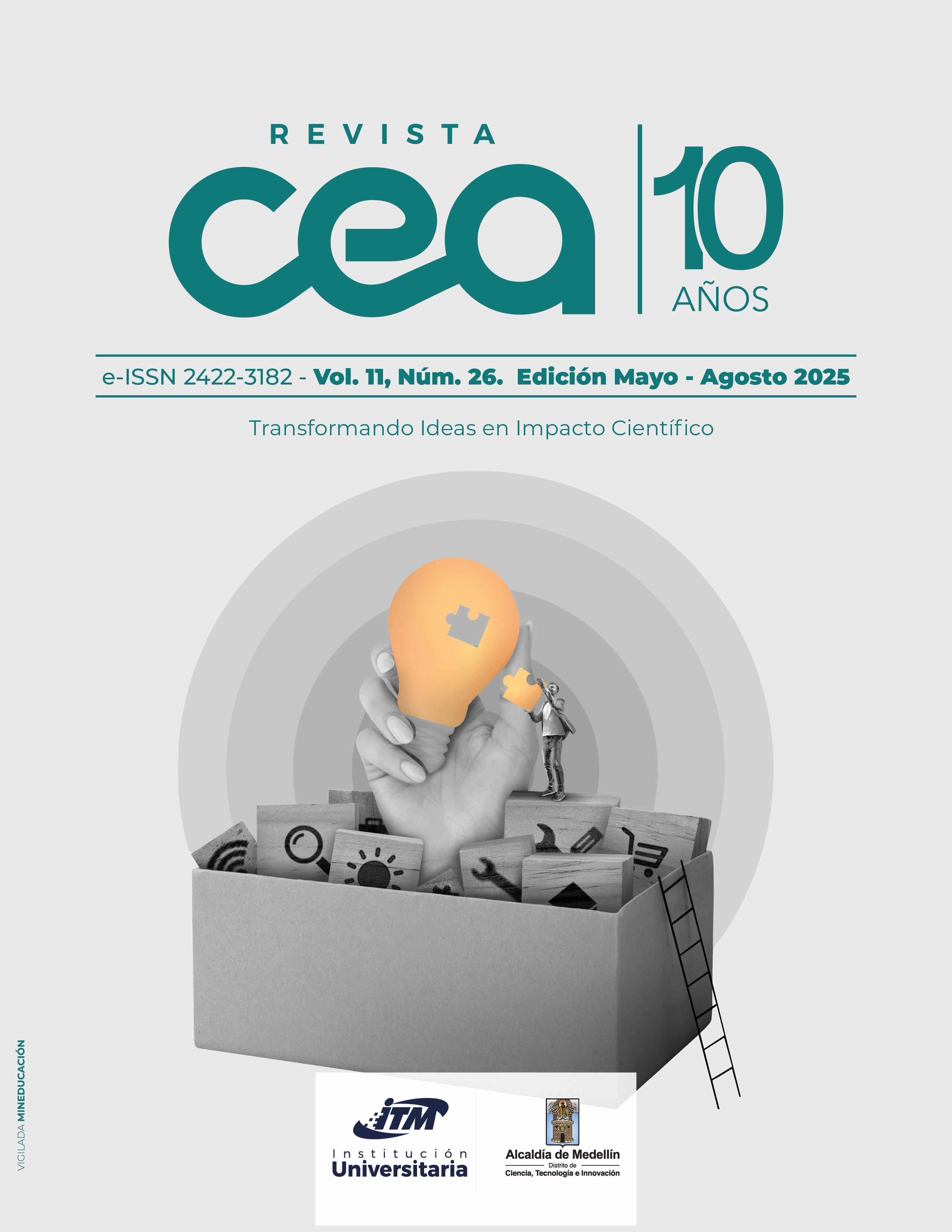Application of the Zavgren Model for Assessing Financial Insolvency in the Construction Industry (2018–2022)
Abstract
Objective: To identify the feasibility of applying the Zavgren model for estimating the probability of financial insolvency among Colombian construction firms between 2018 and 2022.
Design/Methodology: Adopting a quantitative, exploratory, and descriptive approach this study examines the predictive capacity of the Zavgren model within the context of the Colombian construction industry. To this end, a sample of 734 firms that systematically reported financial information from 2018 to 2022 was analyzed.
Findings: More than 80% of the firms assessed were classified in the bankruptcy zone, which reflects significant financial vulnerability within the industry. However, year-over-year variation in insolvency risk was also observed, suggesting that despite the model’s indication of elevated overall risk, insolvency conditions across firms are heterogeneous.
Conclusions: The findings reveal a high proportion of firms at risk of insolvency, as well as substantial heterogeneity in risk levels across the sample. While the Zavgren model proves effective in identifying overall insolvency risk within the industry, its ability to discriminate between different levels of risk remains limited, likely due to industry-specific factors and characteristics not accounted for in the model.
Originality: This is the first study to apply the Zavgren model in the Colombian context, offering insights into its relevance and limitations. It combines cross-sectional and longitudinal statistical analyses over a five-year period, enhancing understanding of financial insolvency dynamics and the impact of firm-level endogenous variables. The study also underscores the importance of adapting insolvency prediction models to the specific conditions of emerging markets such as Colombia.
References
Alaka, H. A., Oyedele, L. M., Owolabi, H. A., Kumar, V., Ajayi, S. O., Akinade, O. O., & Bilal, M. (2018). Systematic review of bankruptcy prediction models: Towards a framework for tool selection. Expert Systems with Application, 94, 164-184. https://doi.org/10.1016/j.eswa.2017.10.040
Andriani, S. F., Rahardja, L., Efriadi, A. R., & Cindi, R. J. (2023). Comparative Analysis of Financial Distress Models in Indonesian Multi-Industrial Manufacturing During COVID-19. International Journal of Digital Entrepreneurship and Business, 4(2), 108-118. https://doi.org/10.52238/ideb.v4i2.130
Anton, C. E., Baba, C. M., & Bucșoiu, O. A. (2025). Perspectives on Integrating Risk Management and Sustainability for Financial Performance: A Systematic Literature Review. Sustainability, 17(8), 3456. https://doi.org/10.3390/su17083456
Aziz, A., Emanuel, D. C., & Lawson, G. H. (1988). Bankruptcy prediction—An investigation of cash flow based models. Journal of Management Studies, 25(5), 419-437. https://doi.org/10.1111/j.1467-6486.1988.tb00708.x
Balina, R., Idasz-Balina, M., & Azam Achsani, N. (2021). Predicting Insolvency of the Construction Companies in the Creditworthiness Assessment Process—Empirical Evidence from Poland. Journal of Risk and Financial Management, 14(10), 453. https://doi.org/10.3390/jrfm14100453
Beade, Á., Rodríguez, M., & Santos, J. (2024). Multiperiod bankruptcy prediction models with interpretable single models. Computational Economics, 64(3), 1357-1390. https://doi.org/10.1007/s10614-023-10479-z
Bermeo Chiriboga, D. C., & Armijos Cordero, J. C. (2021). Predicción de quiebra bajo el modelo Z2 Altman en empresas de construcción de edificios residenciales de la provincia del Azuay. Revista Economía y Política, (33), 48-63. https://doi.org/10.25097/rep.n33.2021.03
Bohórquez Alfonso, G. N. (2019). Modelo de predictibilidad de quiebra para las empresas colombianas del subsector de servicios profesionales [tesis de maestría, Colegio de Estudios Superiores de Administración]. Repositorio CESA. http://hdl.handle.net/10726/2192
Cámara Colombiana de la Construcción. (2022). Tendencias de la Construcción: Economía y coyuntura sectorial. Edición N.° 23. Camacol. https://camacol.co/sites/default/files/descargables/TENDENCIAS%20ED%2023%20-%20JUNIO%2010%20DE%202022-1-DE%20BAJA_compressed.pdf
Charitou, A., Neophytou, E., & Charalambous, C. (2004). Predicting corporate failure: empirical evidence for the UK. European Accounting Review, 13(3), 465-497. https://doi.org/10.1080/0963818042000216811
Dankiewicz, R. (2020). Analysis of companies’ bankruptcy in poland as compared with the cost of protection under trade credit insurance. Journal of International Studies, 13(4), 197-212. https://doi.org/10.14254/2071-8330.2020/13-4/14
Dasilas, A., & Rigani, A. (2024). Machine learning techniques in bankruptcy prediction: A systematic literature review. Expert Systems with Applications, 255(Part C), 124761. https://doi.org/10.1016/j.eswa.2024.124761
Dukalang, E., Zamzam, I., & Abu, Z. (2024). Analysis of Financial Distress Predictions Using Altman, Zavgren, Fulmer, Ohlson, Taffler, and Ca-Score Models as Early Warning Systems in Manufacturing Companies. Nominal Barometer Riset Akuntansi dan Manajemen, 13(1), 81-97. https://doi.org/10.21831/nominal.v13i1.65081
Enshassi, A., Al-Hallaq, K., & Mohamed, S. (2006). Causes of contractor's business failure in developing countries: the case of Palestine. Journal of construction in developing countries, 11(2), 1-14. http://web.usm.my/jcdc/vol11_2_2006/1%20Adnan%20(p.1-14).pdf
Im, H., Minchin, E., Hakim, H., & Zhang, Y. (2018). Monitoring the financial trends of construction firms in Korea, Japan, and the United States by using Bankruptcy Prediction Model. En C. Wang, C. Harper, Y. Lee, R. Harris & C. Berryman (eds.), Construction Research Congress 2018 (pp. 294-304). ASCE. https://ascelibrary.org/doi/10.1061/9780784481271.029
Indriyanti, N. D., & Gustyana, T. T. (2021). Analysis of bankruptcy prediction using Altman Z-Score, Springate Grover, Zmijewski and Zavgren in retail trade sub sectors registered in Indonesia stock exchange period 2015-2019. International Journal of Advanced Research in Economics and Finance, 3(1), 21-31. https://myjms.mohe.gov.my/index.php/ijaref/article/view/12475
International Monetary Fund. (2022). Colombia. 2022 Article IV Consultatio-Press Release; Staff Report; and Statement by the Executive Director for Colombia. IMF Country Report No. 22/97, 1-85. https://www.imf.org/-/media/Files/Publications/CR/2022/English/1COLEA2022002.ashx
Isaac Roque, D., & Caicedo Carrero, A. (2021). Relación entre la creación de valor económico y la insolvencia financiera en empresas no cotizantes en el mercado de valores de Colombia (2016-2019). Semestre Económico, 24(57), 76-97. https://doi.org/10.22395/seec.v24n57a4
Isaac-Roque, D., & Caicedo-Carrero, A. (2023). Relación entre los indicadores financieros del modelo Altman Z y el puntaje Z. Retos Revista de Ciencias de la Administración y Economía, 13(25), 129-148. https://doi.org/10.17163/ret.n25.2023.09
Isaac-Roque, D., Caicedo-Carrero, A., & Muñoz-Álvarez, A. N. (2023). Capacidad predictiva del modelo Altman Z-Score en empresas declaradas en reorganización empresarial. Apuntes de Economía y Sociedad, 4(1), 129-141. https://doi.org/10.5377/aes.v4i1.16451
Janrosl, V. S. E., Prima, A. P., & Yuliadi, Y. (2022). Potensi kebangkrutan menggunakan model Zavgren dan Altman pada perusahaan di Indonesia. Measurement Jurnal Akuntansi, 16(2), 159-165. https://www.journal.unrika.ac.id/index.php/measurement/article/view/4593
Kanapickiene, R., & Marcinkevicius, R. (2014). Possibilities to apply classical bankruptcy prediction models in the construction sector in Lithuania. Economics and Management, 19(4), 317-332. http://dx.doi.org/10.5755/j01.em.19.4.8095
Karas, M., & Řežnáková, M. (2012). Financial ratios as bankruptcy predictors: The Czech Republic case. En D. Pavelková, J. Strouhal, y M. Pasekova (eds.), Proceeding of the 1st WSEAS International Conference on Finance, Accounting and Auditing (pp. 56-67). Tomas Bata University in Zlín-Wseas. https://wseas.us/e-library/conferences/2012/Zlin/FAA/FAA-13.pdf
Keasey, K., & Watson, R. (1987). Non-financial symptoms and the prediction of small company failure: a test of Argenti’s hypotheses. Journal of Business Finance & Accounting, 14(3), 335-354. https://doi.org/10.1111/j.1468-5957.1987.tb00099.x
Klaudiusz Tomczak, S. (2023). General bankruptcy prediction models for the Visegrád Group. The stability over time. Operations Research and Decisions, 33(4), 171-187. https://doi.org/10.37190/ord230410
Kliestik, T. (2018). The Application of Mathematical Modeling to Predict the Financial Health of Businesses. Advances in Economics Business and Management Research, 56, 298-302. https://doi.org/10.2991/febm-18.2018.67
Kristanti, F. T. (2019). Financial Distress: Teori dan Perkembangannya dalam Konteks Indonesia. Intelegensia Media. https://inteligensiamedia.com/product/financial-distress-teori-dan-perkembangannya-dalam-konteks-indonesia/
Kušter, D., Vuković, B., Milutinovic, S., Peštović, K., Tica, T., & Jakšić, D. (2023). Early Insolvency Prediction as a Key for Sustainable Business Growth. Sustainability, 15(21), 15304. https://doi.org/10.3390/su152115304
Lin, Y. C., Padliansyah, R., Lu, Y. H., & Liu, W. R. (2025). Bankruptcy prediction: Integration of convolutional neural networks and explainable artificial intelligence techniques. International Journal of Accounting Information Systems, 56, 100744. https://doi.org/10.1016/j.accinf.2025.100744
Lisnawati, L., Mirnawati, M., Sulaiman, F., & Sari, R. A. (2021). Z-Score and Zavgren Models in Implementing Financial Distress Management in Cigarette Companies. Enrichment: Journal of Management, 12(1), 669-686. https://enrichment.iocspublisher.org/index.php/enrichment/article/view/290
Mehmood, A., & De Luca, F. (2023). Financial distress prediction in private firms: developing a model for troubled debt restructuring. Journal of Applied Accounting Research, 26(6), 1-18. https://doi.org/10.1108/JAAR-12-2022-0325
Narvekar, A., & Gua, D. (2021). Bankruptcy prediction using machine learning and an application to the case of the COVID-19 recession. Data Science in Finance and Economics, 1(2), 180-195. https://doi.org/10.3934/DSFE.2021010
Ohlson, J. A. (1980). Financial ratios and the probabilistic prediction of bankruptcy. Journal of Accounting Research, 18(1), 109-131. https://doi.org/10.2307/2490395
Peña Ortiz, D. C., García Villarreal, J. A., & Morales Castro, A. (2018). Pronóstico de insolvencia financiera para empresas del sector construcción que cotizan en la bolsa caso: México y Colombia. En M. I. Redondo Ramírez, A. M. Barrera Rodríguez y C. C. Duque Gómez (eds.), Internacionalización de la Investigación en las Ciencias Sociales (pp. 259-277). Universidad Libre de Colombia.
Platt, H. D., & Platt, M. B. (1990). Development of a class of stable predictive variables: the case of bankruptcy prediction. Journal of Business Finance & Accounting, 17(1), 31-51. https://doi.org/10.1111/j.1468-5957.1990.tb00548.x
Prusak, B. (2018). Review of research into enterprise bankruptcy prediction in selected central and eastern European countries. International Journal of Financial Studies, 6(3), 60. https://doi.org/10.3390/ijfs6030060
Radovanovic, J., & Haas, C. (2023). The evaluation of bankruptcy prediction models based on socio-economic costs. Expert Systems with Applications, 227, 120275. https://doi.org/10.1016/j.eswa.2023.120275
Rivendra, U., Sudjono, S., & Saluy, A. (2021). Financial Distress Prediction: Case Study Plantation Companies Listed on Indonesia Stock Exchange. En S. Suraya, D. Asih, R. Briandana, M. Rohmadi y K. Saddhono (eds.), Proceedings of the 1st MICOSS Mercu Buana International Conference on Social Sciences, MICOSS 2020, September 28-29, 2020, Jakarta, Indonesia. EAI. http://dx.doi.org/10.4108/eai.28-9-2020.2307365
Rizqon, M., & Yunita, I. (2024). Survival and Transformation: Assessing the Financial Resilience of Indonesian Tourism Companies Pre, During, and Post-COVID-19. International Research Journal of Economics and Management Studies IRJEMS, 3(2), 107-115. https://irjems.org/irjems-v3i2p115.html
Roque, D. I., & Caicedo Carrero, A. (2022). Detección de insolvencia financiera mediante el modelo Z-Altman en empresas colombianas no cotizantes durante el periodo 2016-2019. Contabilidad y Negocios, 17(33), 167-192. https://doi.org/10.18800/contabilidad.202201.007
Sarmiento Rojas, J. A., Hernández Carrillo, C. G., & Rueda Varón, M. J. (2022). Factores de permanencia empresarial del sector de la construcción en Colombia. Editorial UPTC.
Sebastian, B. (2023). A study on the accuracy of bankruptcy models predicting financial distress levels of companies: evidence from Indian stock market [tesis de maestría, Christ Deemed to Be University]. http://dx.doi.org/10.2139/ssrn.4422924
Sheppard, J. P. (1994). Strategy and bankruptcy: an exploration into organizational death. Journal of Management, 20(4), 795-833. https://doi.org/10.1016/0149-2063(94)90031-0
Shi, Y., & Li, X. (2019a). A bibliometric study on intelligent techniques of bankruptcy prediction for corporate firms. Heliyon, 5(12), e02997. https://doi.org/10.1016/j.heliyon.2019.e02997
Shi, Y., & Li, X. (2019b). An overview of bankruptcy prediction models for corporate firms: A systematic literature review. Intangible Capital, 15(2), 114-127. https://doi.org/10.3926/ic.1354
Stankevičienė, J., & Prazdeckaitė, G. (2021). Analysis of the accuracy of bankruptcy prediction models: the case of Lithuanian companies. Apskaitos ir finansų mokslas ir studijos: problemos ir perspektyvos, 15(1), 44-53. https://doi.org/10.15544/ssaf.2021.05
Talebnia, G., Karmozi, F., & Rahimi, S. (2016). Evaluating and comparing the ability to predict the bankruptcy prediction models of Zavgren and Springate in companies accepted in the Tehran Stock Exchange. Marketing and Branding Research, 3, 137-143. https://ssrn.com/abstract=3340454
Urazán-Bonells, C. F., Rondón-Quintana, H. A., & Caicedo-Londoño, M. A. (2024). The Effects of Economic Sector GDP on Low-Income Housing Supply, Colombia’s Regions Case. Buildings, 14(1), 267. https://doi.org/10.3390/buildings14010267
Vargas Franco, V. (2007). Estadística descriptiva para Ingeniería Ambiental con SPSS. Universidad Nacional de Colombia.
Vásquez-Serpa, L. J., Rodríguez, C., Pérez-Núñez, J. R., & Navarro, C. (2025). Challenges of Artificial Intelligence for the Prevention and Identification of Bankruptcy Risk in Financial Institutions: A Systematic Review. Journal of Risk and Financial Management, 18(1), 26. https://doi.org/10.3390/jrfm18010026
Wahyuni, I. A., Laba, A. R., & Rahim, F. R. (2024). Comparative Analysis of Altman Method Measurement, Springate, Zmijewski and Grover in Predicting Financial Distress. Economics and Digital Business Review, 5(2), 674-687. https://ojs.stieamkop.ac.id/index.php/ecotal/article/view/1700/1132
Wang, J., Li, M., Moorhead, M., & Skitmore, M. (2025). Forecasting financial distress in listed Chinese construction firms: leveraging ensemble learning and non-financial variables. Construction Management and Economics, 43(3), 175-195. http://dx.doi.org/10.1080/01446193.2024.2403553
Wardayani, W., & Maksum, A. (2020). Analisis Potensi Kebangkrutan: Perbandingan Model Altman dengan Zavgren. PERSPEKTIF, 9(2), 447-452. https://doi.org/10.31289/perspektif.v9i2.3946
Wassie, F. A., & Lakatos, L. P. (2024). Key audit matters disclosure: do they reveal construction firm’s risk of financial distress? Evidence from Ethiopia. International Journal of Construction Management, 24(15), 1689-1697. https://doi.org/10.1080/15623599.2023.2286882
Wicaksono, K., Musa, P., Bangun, A. A., Lestari, O. B., Aryunani, W., & Sukmono, S. (2022). Analysis of Financial Annual Reports for Bankruptcy Predictions Using Altman Z-Score Method. Journal of Intelligent Decision Support System (IDSS), 5(2), 44-52. https://doi.org/10.35335/idss.v5i2.79
Zavgren, C. V. (1985). Assessing the vulnerability to failure of American industrial firms: a logistic analysis. Journal of Business Finance and Accounting, 12(1), 19-45. https://doi.org/10.1111/j.1468-5957.1985.tb00077.x
Downloads
Copyright (c) 2025 Andrés Caicedo Carrero, Daniel Isaac Roque

This work is licensed under a Creative Commons Attribution-NonCommercial-ShareAlike 4.0 International License.

| Article metrics | |
|---|---|
| Abstract views | |
| Galley vies | |
| PDF Views | |
| HTML views | |
| Other views | |







